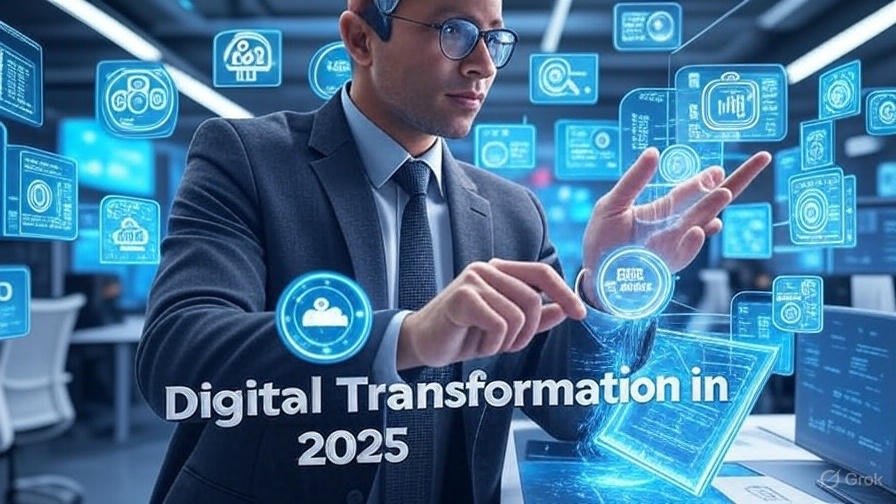Explore how digital transformation is changing business and life in 2025. Learn key trends, tech tools, and how to thrive in the digital-first world.
We live in a time where technology isn’t just supporting business — it is redefining how companies operate, how people live, and how we all connect. In 2025, digital transformation is no longer a choice but a necessity for businesses, governments, and individuals to survive and thrive in a fast-paced, connected world.
From artificial intelligence (AI) to cloud computing, automation, and remote work technologies, digital transformation is driving efficiency, innovation, and global reach. But what exactly is digital transformation, and how can you adapt to it in 2025?
In this blog post, you’ll learn what digital transformation really means, the key technologies behind it, the industries being disrupted, and most importantly, how you can prepare for success in a digital-first world.
1. What Is Digital Transformation?
Digital transformation refers to the integration of digital technologies into all areas of life and business, fundamentally changing how we operate and deliver value to customers or users.
It goes beyond just adopting new tools — it’s about rethinking processes, culture, and customer experiences using technology.
Key Components:
- Automating manual tasks
- Leveraging data for decision-making
- Improving customer experience through digital channels
- Adopting cloud computing, AI, and mobile solutions
2. Why Digital Transformation Matters in 2025
In 2025, digital transformation is the key to competitiveness, innovation, and survival.
Why Businesses Must Embrace It:
- Customers demand faster, personalized service
- Global markets require remote capabilities
- Automation reduces costs and human error
- Digital-first companies attract better talent and investments
For Individuals:
Digital transformation is changing how we work, learn, shop, and communicate. Understanding it helps you remain relevant and future-proof your career.
3. Key Technologies Driving Digital Transformation
Let’s explore the top technologies powering the digital revolution.
1. Cloud Computing
The cloud enables businesses and individuals to store, access, and process data from anywhere.
Key Platforms:
- Amazon Web Services (AWS)
- Microsoft Azure
- Google Cloud Platform
Benefits:
- Scalability and flexibility
- Cost savings
- Remote access and collaboration
2. Artificial Intelligence and Automation
AI and automation streamline operations, analyze data, and enhance customer service.
Use Cases:
- AI chatbots for 24/7 customer support
- Predictive analytics for sales and marketing
- Automated inventory and supply chain systems
3. Internet of Things (IoT)
IoT devices collect and share real-time data, improving decision-making and efficiency.
Examples:
- Smart home devices
- Industrial IoT sensors
- Wearables tracking health data
4. 5G Connectivity
5G networks power real-time data exchange and enable smart cities, remote work, and telemedicine.
5. Cybersecurity Technologies
As digital adoption grows, so do threats. Cybersecurity tools protect data, systems, and privacy.
Key Tools:
- Firewalls, encryption, VPNs
- Identity and access management
- AI-driven threat detection
6. Blockchain Technology
Blockchain ensures secure, transparent, and decentralized transactions.
Use Cases:
- Supply chain tracking
- Digital identity verification
- Financial transactions (DeFi)
7. Robotic Process Automation (RPA)
RPA uses software robots to handle repetitive tasks, improving speed and accuracy.
Examples:
- Invoice processing
- Data entry
- HR onboarding
4. Digital Transformation in Different Industries
Let’s look at how digital tech is disrupting major sectors:
Healthcare
- Telehealth and virtual consultations
- AI-driven diagnostics
- Electronic health records (EHRs)
- Remote patient monitoring
Education
- E-learning platforms (Coursera, Udemy)
- Virtual classrooms and webinars
- AI tutors and personalized learning
- Learning management systems (LMS)
Finance
- Digital banking and mobile payments
- Robo-advisors for investments
- Blockchain for secure transactions
- Fraud detection through AI
Retail and E-commerce
- Online shopping with AR/VR
- Personalized product recommendations
- Automated warehouses and logistics
- Omnichannel marketing
Manufacturing
- Smart factories using IoT sensors
- Predictive maintenance
- Robotics and automation
- Real-time supply chain visibility
Agriculture
- Drones for crop monitoring
- Smart irrigation systems
- AI for yield prediction
- Blockchain for food traceability
5. Benefits of Embracing Digital Transformation
Adopting digital tools provides massive advantages:
For Businesses:
- Increased productivity and efficiency
- Better customer experience and engagement
- Data-driven decisions
- Competitive edge
For Individuals:
- Access to global job opportunities
- Flexible work and learning options
- Improved communication and collaboration
- Ability to build personal brands online
6. Challenges in the Digital Age
While the digital shift offers many benefits, challenges remain.
Common Challenges:
- Cybersecurity risks
- Resistance to change
- Skill gaps in digital literacy
- Cost of implementation for small businesses
Solution:
- Continuous learning and upskilling
- Investing in cybersecurity and IT infrastructure
- Embracing change with open-minded leadership
7. How Individuals Can Prepare for a Digital Future
To thrive in a digital world, you need to upgrade your skills and mindset.
Action Steps:
- Learn Digital Tools: Get comfortable with cloud apps, collaboration platforms, and data analytics tools.
- Improve Tech Literacy: Understand basic concepts of AI, IoT, cybersecurity, and blockchain.
- Get Certified: Explore certifications from Google, Microsoft, AWS, and Coursera.
- Stay Informed: Follow tech blogs, YouTube channels, and industry leaders.
- Be Adaptable: Embrace new tools and workflows — don’t fear change.
- Network Digitally: Use LinkedIn and online communities to connect with peers and mentors.
- Secure Your Digital Life: Learn basic cybersecurity to protect your data.
8. Final Thoughts: Adapt or Fall Behind
Digital transformation is here to stay — and it’s only accelerating. Whether you’re running a business or planning your career, embracing technology is the key to growth and success in 2025.
Those who act now will gain a competitive edge, unlock new opportunities, and thrive in the digital-first economy.
Start learning, adapting, and transforming today. Your future is digital — and it begins now with Topgoalz.

